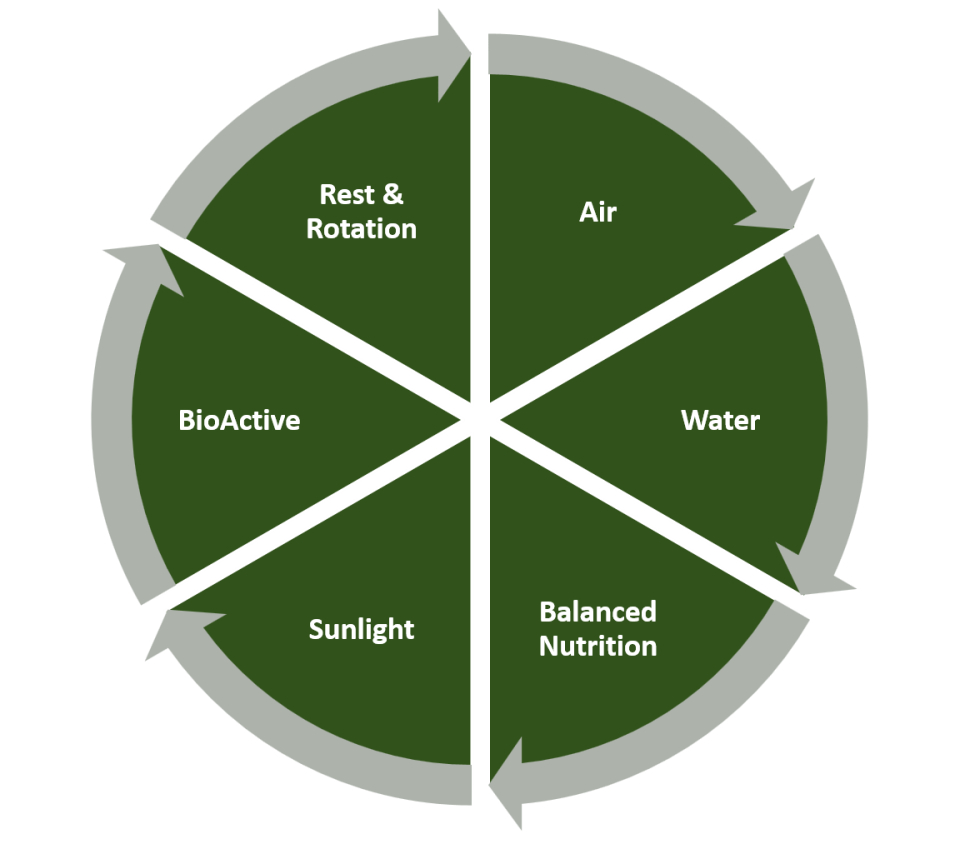Soil Health Principles
The following principles where designed to provide an overview of what is happening in a healthy soil and to be a field guide when assessing soil health indicators.

A healthy soil is the result of taking the basic steps to ensure proper function. Firstly, a soil requires the right amount of air and water for roots and good biology to have a comfortable home to live in. Balanced nutrition is then required to feed both the soil and the plant. When these foundation elements come together, plants can begin to harvest the sunlight efficiently and convert it into metabolic energy in the form of sugars. The plant then pumps out these sugars, feeding the food web and creating a bioactive soil. Carbon levels increase and the soil becomes progressively more fertile. The last step for sustainable soil health is a long-term rest and rotation plan to ensure continual production.
Air

Can it breathe?
A living soil must be able to breathe. Soil microbes and roots uptake oxygen and release carbon dioxide. To function properly they need a soil that allows air to move through the structure. Pore spaces, old root cavities and worm tunnels all create air passageways. While tillage restores aeration temporarily in a compact soil, it disturbs some of these naturally formed air spaces.
Signs of a problem:
- Stunted growth
- Poor root development
How can you observe it?
- When you dig a hole, replace the soil back in the hole. If the soil level is higher, you have increased the air space (ie tillage). If the soil level drops after digging, you have reduced the naturally occurring air space.
- A Soil Penetrometer measures soil compaction through out the profile. Alternatively, a long screwdriver or a spade can be used to feel the soil's resistance. The soil is too hard if you need to jump on the spade.
- The soil texture, made up of sand, silt and clay will influence the soil's natural tendency to hold air. Sandy soils have more air space.
- Bulk Density Measurement (instructions coming)
Ways to improve the situation:
- Increase oxygen spaces through intelligent tillage
- Manage Calcium to Magnesium Ratio
- Increase drainage to remove excess water
- Break the hardpan for free flow of water and air
- Develop a healthy worm environment
- Any action that improves soil structure, for example adding organic matter
Water

Is there a water problem?
Soil water is the open food table for roots and soil biology to live in and exchange resources between each other. When the soil dries, the exchange slows down and growth stops. A wilting plant will slow its uptake of nutrients and stop pumping exudates into the ground. The soil's capacity to provide water to the plant is dependent on root depth and soil structure.
Signs of a problem:
- Low yields
How can you observe it?
- Puddles that don't drain
- Water run off rather then absorption due to compaction/poor drainage
- Water phobic characteristics
- Observe water infiltration into the soil with a PVC pipe - Instructions
- Measure how much water the soil can hold with a Bulk Density Measurement (instructions coming)
- Do the roots reach the moisture? Consider rooting depth
- Smell: a swamp stench can occur when there is too much water and the soil turns anaerobic
Ways to improve the situation:
- Increase drainage to remove excess water
- Break the hardpan for free flow of water and air downwards
- Increase rooting depth for access to more water
- Improve soil structure to increase water holding capacity and infiltration
- Maintain soil cover to reduce soil surface compaction/plugging by rain
- A well managed irrigation budget
- Avoid working the soil during or before heavy rain
Balanced Nutrition

Is nutrition holding us back?
A healthy soil has all the nutritional building blocks to build a health plant and feed the soil biology. By balancing soil minerals, the pH returns to a normal 6.5. A good pH provides a functioning environment for plant roots and nutrient interactions. Correcting the soil's nutritional deficiencies is the first step to optimising quality, disease resistance and yield.
Signs of a problem:
- Poor growth/leaf symptoms
- High levels of disease/pests
- Poor quality produce
- Overwhelming weeds
- Soil sets hard when dry
- Shallow roots limit access to nutrition
How can you observe it?
- Manutec pH kit
- Soil Test
Ways to improve the situation:
- Mineral fertilisers
- Soil amendments eg. organic matter
- Plant nitrogen fixing crops
- Recycle nutrients by avoiding unnecessary removal of organic material
- Increase rooting depth by correcting subsoil nutritional characteristics
Sunlight

What powers the system?
The primary job of agriculture is to capture solar energy and transform it into stored energy, or as we know it, food. The light of the sun is the basic raw material that powers the system. This is critical for growth but also for soil health because plants that photosynthesis efficiently have surplus energy too donate to the soil biology in the form of exudates. When photosynthesising effectively, the sun is able to power the entire soil food web.
Signs of a problem:
- Slow growth
- Soil borne disease due to lack of exudates from plant roots
How can you observe it?
- Hours of sunlight exposure
- Brix meter gives an indication of how effectively plants are photosynthesising
- Darkening of soil colour over time as exudates increase biological activity around roots
- Root dreadlocks show that exudates are gluing the soil together
Ways to improve the situation:
- Choose a sunny place
- Choosing crops and cover crops that will grow at full capacity
- Achieve high photosynthetic efficiency by ensuring air and water are not limiting growth
- Target nutrition that is responsible for supporting photosynthesis
- Foliar feeding that increases photosynthesis efficiency
BioActive

Is it alive?
The soil food web is the work engine that digs for nutrients, creates soil structure, and protects plants from disease (ie. bad microbes). A plant has its own microbiome: a dense population of microbes that live on the plant’s roots, leaves and even inside it. They help the plant sense and function in its environment. For example, mycorrhizal fungi develop a working relationship with plants by providing the nutrients in exchange for energy harvested from the sun.
Signs of a problem:
- Light coloured soil shows lack of biological activity and reduced carbon levels
- No worms or critters
- Diseases
How can you observe it?
- Worm count: 45 worms in a spade full would be ideal, remembering that worms retreat during dry weather
- Bug count
- Microscope fungi/bacteria count
- Smell: fungal soils have a wet forest smell - sweet, rich or musty. Bacterial soil will smell more mineral like.
Ways to improve the situation:
- Maximise photosynthesis for exudate formation
- Maintain soil cover and good biomass
- Balanced nutrition creates a friendly soil environment and food source for microbes
- Feed the microbes eg. green manures, Humic/Fulvic Acids, kelp
- Amendments that contain organic matter, such as compost or manures
Rest & Rotations

How much work is enough?
Soils get tired just like any living system and by rotating between crops they can rest some resources whilst using others. At times however, a soil may need a complete rest to maintain high performance.
Signs of a problem?
- Plant disease pressures increase
- Poor growth/yields
- A lack of eagerness to produce, typically experienced by soils which have been in production for long periods of time
Ways to improve the situation:
- Make a rest & rotation plan between cash crops and cover crops that have different nutritional demands and benefits
- Deciding on sustainable yield targets that do not degrade soil health
